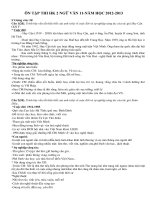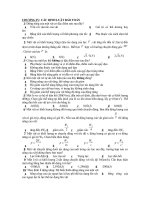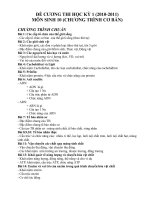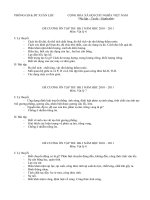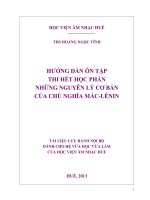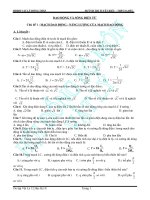Ôn tập thi LÝ THUYẾT DỊCH TRANSLATION THEORY
Bạn đang xem bản rút gọn của tài liệu. Xem và tải ngay bản đầy đủ của tài liệu tại đây (332.96 KB, 45 trang )
REVISION
Translation Theory
Ihr Logo
CONTENT
1. Examination Format
2. Revision
3. Tip sharing
Here comes your footer Page 2
Your Logo
Part 1: GENERAL FORMAT
Task 1: True/False (1pts – 5Q)
Task 2: Gap-filling (2pts – 8Q)
Task 3: Matching (2pts – 8Q)
Here comes your footer Page 3
Your Logo
Examples
Adaptation is mainly used for translation of
songs, plays, etc.
…………..is used when a source language
grammatical structure does not exist in the
target language.
Here comes your footer Page 4
Your Logo
2. REVISION (Theory)
Text Analysis
Translation Methods
Translation Procedures
Translation Equivalence
Translation Revision
Here comes your footer Page 5
Your Logo
TEXT ANALYSIS
Readership:
+ Definition: a group that readers that the
text is aimed at
+ Features: level of education, class, age,
gender
+ Types: expert, educated layman, the
uninformed
Here comes your footer Page 6
Your Logo
TRANSLATION METHODS
8 methods – Peter Newmark
Here comes your footer Page 7
Your Logo
Word – for – word translation
Source language word-order is preserved
words are translated singly by their most
common meanings, out of context
and non – grammatical
Here comes your footer Page 8
Your Logo
Literal translation
Source language grammatical structures
are converted to their nearest equivalent
in the target language.
But words are still translated singly, out
of context.
Here comes your footer Page 9
Your Logo
Faithful translation
Words are translated in context.
Uncompromising to the target language.
Transfer cultural words
Does not naturalize
Here comes your footer Page 10
Your Logo
Semantic translation
Naturalize to achieve aesthetic effect
Great focus on aesthetic features of the
source text (at expense of meaning if
necessary)
Close rendering of metaphors,
collocations, technical terms,
colloquialisms, etc
Here comes your footer Page 11
Your Logo
Semantic translation
Used for:
- Texts that have high status (religious
texts, legal texts, politicians’ speeches)
- Expressive texts (literature)
Here comes your footer Page 12
Your Logo
Communicative translation
Freer than semantic translation
Give priority to the effectiveness of the
message to be communicated
Focus on readability and naturalness (the
content and language are readily
acceptable and comprehensible to the
reader)
Here comes your footer Page 13
Your Logo
Communicative translation
Used for: informative texts
Here comes your footer Page 14
Your Logo
Idiomatic translation
Reproduce the message of the original
Prefer colloquialisms and idioms which
do not exist in the original
Outcome: Lively, natural translation
Here comes your footer Page 15
Your Logo
Free translation
Reproduce the matter without the
manner, the content without the form of
the original
Paraphrase much longer than the original
Used for: informative translation, in-
house publication
Here comes your footer Page 16
Your Logo
Adaptation
The freest form of translation
Preserve the theme, plots, characters only
The SL culture is converted to the TL
culture
A kind of rewriting in translation
Used for: plays, poems, songs, advertising
Here comes your footer Page 17
Your Logo
Translation procedures
Memorize names of all procedures
Outstanding characteristics of each
procedure
Here comes your footer Page 18
Your Logo
Transference
A SL word is directly taken into TL text with no
translation
Used for: proper names, proper nouns, new
technical terms that do not have equivalents in
the TL.
To create stylistic effect
Here comes your footer Page 19
Your Logo
Naturalization
A transferred word is adapted to the TL
(pronunciation and morphology)
Here comes your footer Page 20
Your Logo
